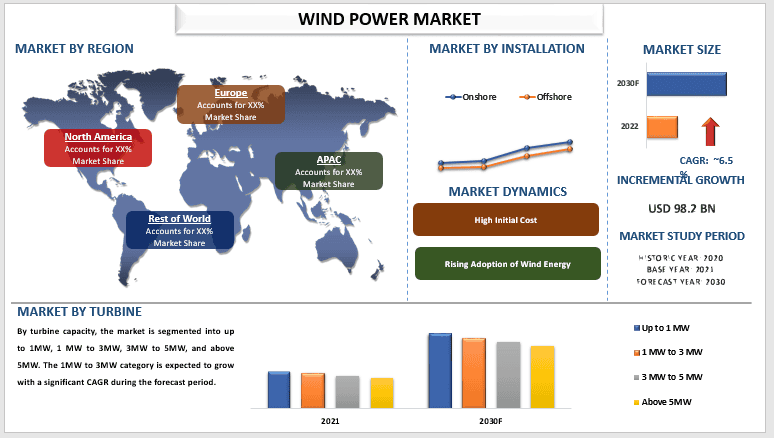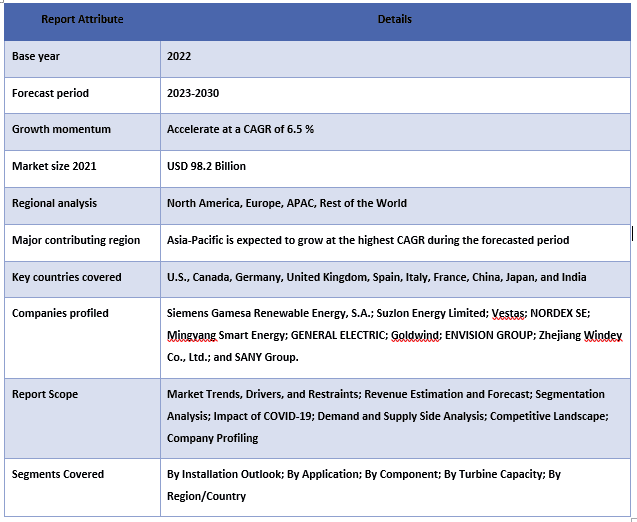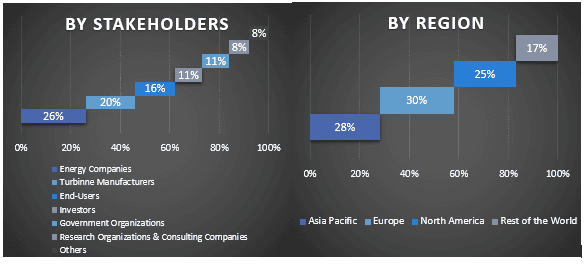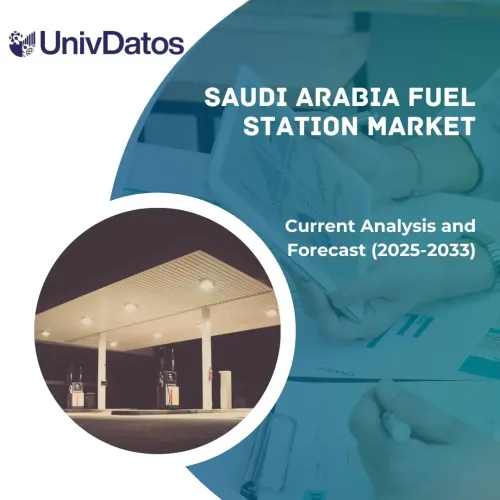- Inicio
- Acerca de nosotros
- Industria
- Servicios
- Leyendo
- Contáctenos
Mercado de energía eólica: análisis actual y pronóstico (2023-2030)
Énfasis en la Instalación de P (En Tierra y Mar Adentro); Capacidad de la Turbina (Hasta 1 MW, 1 MW a 3 MW, 3 MW a 5 MW, y Superior a 5 MW); Aplicación (Servicios Públicos y No Servicios Públicos); Componente (Turbina, Estructura de Soporte, Infraestructura Eléctrica y Otros); Región/País.

El mercado de energía eólica se valoró en USD 98.2 mil millones y se espera que crezca a una fuerte CAGR de alrededor del 6.5% durante el período de pronóstico (2023-2030). El mercado está creciendo con la creciente demanda de fuentes de energía limpia y renovable. Los gobiernos de todo el mundo están implementando políticas para reducir las emisiones de gases de efecto invernadero y combatir el cambio climático, lo que ha llevado a un aumento de las inversiones en proyectos de energía eólica. Además, el costo de la energía eólica ha disminuido significativamente en los últimos años, lo que la convierte en una opción cada vez más competitiva en costos en comparación con las fuentes de energía tradicionales como los combustibles fósiles. Además, los avances en la tecnología han llevado al desarrollo de turbinas eólicas más grandes y eficientes, lo que permite generar más electricidad a partir de la misma cantidad de energía eólica. Finalmente, la naturaleza intermitente de la energía eólica puede abordarse mediante el uso de tecnologías de almacenamiento de energía, lo que aumenta aún más su viabilidad como fuente de energía confiable y sostenible.
Algunos de los principales actores que operan son Siemens Gamesa Renewable Energy, S.A.; Suzlon Energy Limited; Vestas; NORDEX SE; Mingyang Smart Energy; GENERAL ELECTRIC; Goldwind; ENVISION GROUP; Zhejiang Windey Co., Ltd.; y SANY Group. Estos actores han emprendido varias fusiones y adquisiciones junto con asociaciones para facilitar a los clientes productos/tecnologías innovadores y de alta tecnología.
Perspectivas presentadas en el informe
"Entre las perspectivas de instalación, el segmento offshore crecerá con una alta CAGR durante el período de pronóstico"
Según la perspectiva de instalación, el mercado se bifurca en onshore y offshore. Se prevé que el segmento offshore crezca con una CAGR significativa durante el período de pronóstico. El mercado de energía eólica offshore está impulsado por una variedad de factores, incluida la creciente demanda de energía limpia, los avances tecnológicos, el aumento del apoyo gubernamental y la disminución de los costos. La necesidad de reducir las emisiones de carbono y combatir el cambio climático ha llevado a la implementación de políticas y regulaciones que fomentan el desarrollo de fuentes de energía renovables, incluida la energía eólica offshore. Los gobiernos de todo el mundo están proporcionando incentivos financieros y apoyo regulatorio para fomentar el desarrollo de proyectos de energía eólica offshore, y el costo de la energía eólica offshore ha disminuido significativamente en los últimos años, lo que la hace cada vez más competitiva con las fuentes de energía tradicionales. Por ejemplo, la administración Biden se ha fijado el objetivo de desplegar 30 GW de capacidad eólica offshore para 2030, con planes de celebrar subastas de arrendamiento eólico offshore en el Golfo de México, el Atlántico Medio y Nueva Inglaterra.
"Entre las aplicaciones, la categoría no utilitaria crecerá con una alta CAGR durante el período de pronóstico"
Por aplicación, el mercado se bifurca en utilidad y no utilidad. Se espera que la categoría no utilitaria crezca con una alta CAGR durante el período de pronóstico. El segmento no utilitario del mercado de energía eólica incluye proyectos de energía eólica a gran escala que no están conectados a la red, utilizados para la generación de electricidad para comunidades remotas, instalaciones industriales y bases militares. Varios factores, incluida la creciente necesidad de soluciones energéticas confiables y rentables para las comunidades remotas, un aumento de la independencia energética y la creciente demanda de energía renovable en aplicaciones industriales y militares, están impulsando el crecimiento del segmento durante el período de pronóstico.
"Entre los componentes, la categoría de turbinas tendrá una participación significativa del mercado en 2022"
Según el componente, el mercado se clasifica en turbina, estructura de soporte, infraestructura eléctrica y otros. La categoría de turbinas tuvo una participación significativa del mercado en 2022. El segmento de turbinas del mercado de energía eólica incluye los diversos tipos de turbinas eólicas utilizadas en proyectos de energía eólica, como las turbinas eólicas de eje horizontal (HAWT) y las turbinas eólicas de eje vertical (VAWT). El aumento de los avances tecnológicos y el aumento de las inversiones de las empresas son algunos de los principales impulsores del segmento. Los avances tecnológicos en la tecnología de turbinas eólicas han llevado al desarrollo de turbinas eólicas más eficientes y rentables, con un mejor rendimiento y durabilidad. Por ejemplo, en marzo de 2022, Siemens Gamesa Renewable Energy anunció el lanzamiento de su nueva turbina eólica marina, la SG 14-15.0-MW, que está diseñada para su uso en entornos de aguas ultraprofundas.
"América del Norte crecerá con una alta CAGR durante el período de pronóstico"
Se prevé que América del Norte crezca con una CAGR significativa durante los próximos años debido al aumento de la demanda de energía limpia en EE. UU. impulsado por las políticas y regulaciones gubernamentales, así como por la conciencia y las preferencias de los consumidores. Por ejemplo, en agosto de 2021, el Departamento del Interior de EE. UU. anunció planes para celebrar subastas de arrendamiento eólico offshore en el Golfo de México y el Océano Atlántico, con el potencial de desarrollar más de 4 GW de capacidad eólica offshore. Además, el costo de la energía eólica ha disminuido significativamente en los últimos años, lo que la hace cada vez más competitiva con las fuentes de energía tradicionales. Según un informe del Departamento de Energía de EE. UU., el costo nivelado de la electricidad (LCOE) para la energía eólica ha disminuido un 70% desde 2009.
Cobertura del informe del mercado de energía eólica

Razones para comprar este informe:
- El estudio incluye análisis de dimensionamiento y previsión del mercado validados por expertos clave autenticados de la industria.
- El informe presenta una revisión rápida del desempeño general de la industria de un vistazo.
- El informe cubre un análisis en profundidad de los pares prominentes de la industria con un enfoque principal en las finanzas comerciales clave, las carteras de productos, las estrategias de expansión y los desarrollos recientes.
- Examen detallado de los impulsores, las restricciones, las tendencias clave y las oportunidades que prevalecen en la industria.
- El estudio cubre exhaustivamente el mercado en diferentes segmentos.
- Análisis profundo a nivel regional de la industria.
Opciones de personalización:
El mercado global de energía eólica se puede personalizar aún más según los requisitos o cualquier otro segmento de mercado. Además de esto, UMI entiende que puede tener sus propias necesidades comerciales, por lo tanto, no dude en conectarse con nosotros para obtener un informe que se adapte completamente a sus requisitos.
Tabla de contenido
Metodología de Investigación para el Análisis del Mercado de Energía Eólica (2023-2030)
El análisis del mercado histórico, la estimación del mercado actual y la previsión del mercado futuro del mercado mundial de energía eólica fueron los tres pasos principales realizados para crear y analizar la adopción de la energía eólica en las principales regiones del mundo. Se llevó a cabo una exhaustiva investigación secundaria para recopilar las cifras del mercado histórico y estimar el tamaño actual del mercado. En segundo lugar, para validar estos conocimientos, se tomaron en consideración numerosos hallazgos y supuestos. Además, se realizaron exhaustivas entrevistas primarias con expertos de la industria en toda la cadena de valor del mercado mundial de energía eólica. Tras la suposición y validación de las cifras del mercado a través de entrevistas primarias, empleamos un enfoque de arriba hacia abajo/de abajo hacia arriba para pronosticar el tamaño total del mercado. Posteriormente, se adoptaron métodos de desglose del mercado y triangulación de datos para estimar y analizar el tamaño del mercado de los segmentos y subsegmentos de la industria a la que pertenece. La metodología detallada se explica a continuación:
Análisis del Tamaño del Mercado Histórico
Paso 1: Estudio en Profundidad de Fuentes Secundarias:
Se llevó a cabo un estudio secundario detallado para obtener el tamaño del mercado histórico del mercado de energía eólica a través de fuentes internas de la empresa, como informes anuales y estados financieros, presentaciones de rendimiento, comunicados de prensa, etc., y fuentes externas, incluyendo revistas, noticias y artículos, publicaciones gubernamentales, publicaciones de la competencia, informes sectoriales, bases de datos de terceros y otras publicaciones creíbles.
Paso 2: Segmentación del Mercado:
Después de obtener el tamaño del mercado histórico del mercado de energía eólica, llevamos a cabo un análisis secundario detallado para recopilar información y cuotas del mercado histórico para diferentes segmentos y subsegmentos para las principales regiones. Los principales segmentos incluidos en el informe son la perspectiva de instalación, la capacidad de las turbinas, la aplicación y el componente. Además, se realizaron análisis a nivel de país para evaluar la adopción general de los modelos de prueba en esa región.
Paso 3: Análisis de Factores:
Después de adquirir el tamaño del mercado histórico de diferentes segmentos y subsegmentos, llevamos a cabo un análisis de factores detallado para estimar el tamaño actual del mercado de energía eólica. Además, realizamos un análisis de factores utilizando variables dependientes e independientes, como la perspectiva de instalación, la capacidad de las turbinas, la aplicación y el componente del mercado de energía eólica. Se realizó un análisis exhaustivo de los escenarios de la demanda y la oferta, teniendo en cuenta las principales asociaciones, fusiones y adquisiciones, la expansión empresarial y los lanzamientos de productos en el sector del mercado de energía eólica en todo el mundo.
Estimación y Previsión del Tamaño Actual del Mercado
Tamaño Actual del Mercado: Basándonos en la información práctica de los 3 pasos anteriores, llegamos al tamaño actual del mercado, los actores clave en el mercado mundial de energía eólica y las cuotas de mercado de los segmentos. Todos los porcentajes de participación requeridos y los desgloses del mercado se determinaron utilizando el enfoque secundario mencionado anteriormente y se verificaron a través de entrevistas primarias.
Estimación y Previsión: Para la estimación y la previsión del mercado, se asignaron ponderaciones a diferentes factores, incluyendo los impulsores y las tendencias, las restricciones y las oportunidades disponibles para las partes interesadas. Después de analizar estos factores, se aplicaron las técnicas de previsión pertinentes, es decir, el enfoque de arriba hacia abajo/de abajo hacia arriba, para llegar a la previsión del mercado para 2030 para diferentes segmentos y subsegmentos en los principales mercados a nivel mundial. La metodología de investigación adoptada para estimar el tamaño del mercado abarca:
- El tamaño del mercado de la industria, en términos de ingresos (USD) y la tasa de adopción del mercado de energía eólica en los principales mercados a nivel nacional
- Todos los porcentajes de participación, divisiones y desgloses de los segmentos y subsegmentos del mercado
- Los actores clave en el mercado mundial de energía eólica en términos de productos ofrecidos. Además, las estrategias de crecimiento adoptadas por estos actores para competir en el mercado de rápido crecimiento
Validación del Tamaño y la Cuota del Mercado
Investigación Primaria: Se realizaron entrevistas en profundidad con los Líderes de Opinión Clave (KOLs) incluyendo Ejecutivos de Alto Nivel (CXO/VPs, Jefe de Ventas, Jefe de Marketing, Jefe de Operaciones, Jefe Regional, Jefe de País, etc.) en las principales regiones. Los hallazgos de la investigación primaria fueron luego resumidos, y se realizó un análisis estadístico para probar la hipótesis establecida. Los aportes de la investigación primaria se consolidaron con los hallazgos secundarios, convirtiendo así la información en conocimientos prácticos.
División de los Participantes Primarios en Diferentes Regiones

Ingeniería de Mercado
Se empleó la técnica de triangulación de datos para completar la estimación general del mercado y para llegar a cifras estadísticas precisas para cada segmento y subsegmento del mercado mundial de energía eólica. Los datos se dividieron en varios segmentos y subsegmentos después de estudiar varios parámetros y tendencias en las áreas de la perspectiva de instalación, la capacidad de las turbinas, la aplicación y el componente del mercado mundial de energía eólica.
El objetivo principal del Estudio del Mercado Mundial de Energía Eólica
Las tendencias actuales y futuras del mercado mundial de energía eólica fueron identificadas en el estudio. Los inversores pueden obtener información estratégica para basar su discreción para las inversiones en el análisis cualitativo y cuantitativo realizado en el estudio. Las tendencias actuales y futuras del mercado determinaron el atractivo general del mercado a nivel regional, proporcionando una plataforma para que el participante industrial explote el mercado sin explotar para beneficiarse de una ventaja de ser el primero en actuar. Otros objetivos cuantitativos de los estudios incluyen:
- Analizar el tamaño actual y previsto del mercado de energía eólica en términos de valor (USD). Además, analizar el tamaño actual y previsto del mercado de diferentes segmentos y subsegmentos.
- Los segmentos en el estudio incluyen áreas de la perspectiva de instalación, la capacidad de las turbinas, la aplicación y el componente.
- Definir y analizar el marco regulatorio para la energía eólica
- Analizar la cadena de valor involucrada con la presencia de varios intermediarios, junto con el análisis de los comportamientos de los clientes y la competencia de la industria.
- Analizar el tamaño actual y previsto del mercado de energía eólica para la región principal
- Los principales países de las regiones estudiadas en el informe incluyen Asia Pacífico, Europa, América del Norte y el Resto del Mundo
- Perfiles de empresas del mercado de energía eólica y las estrategias de crecimiento adoptadas por los actores del mercado para mantenerse en el mercado de rápido crecimiento
- Análisis en profundidad a nivel regional de la industria
Relacionados Informes
Los clientes que compraron este artículo también compraron










